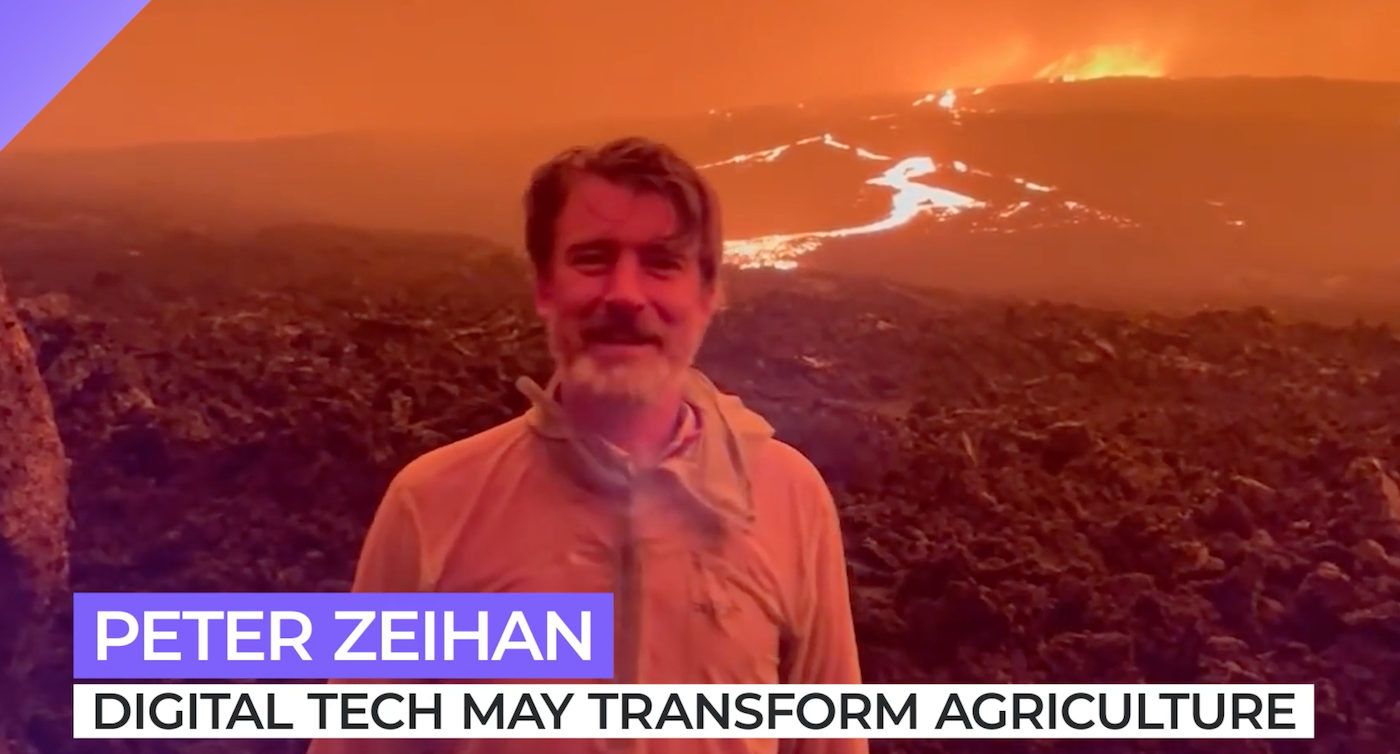
Commentary
-
Our commentary partners will help you reach your own conclusions on complex topics.
And I’m back, because you know how often do you get a backdrop like this?
We’re going to talk about agriculture today.
Some of the questions that have been coming in or what sort of technologies do I see on the horizon that can actually move the needle considering some of the more dire predictions I’ve made and really the only big ones I see are in AG and it’s the marriage of digital technologies to agriculture.
So, when we were new before the industrial revolution most agriculture was really more like gardening, with people tending to each individual plant.
And it’s not that that’s a bad system; that’s a great system. It generates massive amounts of agricultural surplus when plants get individual attention.
But it does mean you need a lot of labor so the only places that still do that sort of agriculture today are in China with some of the rice fields and in some parts of sub-Saharan Africa and Papua New Guinea.
Pretty much everyone else has moved to industrialized agriculture — tractors, combines, fertilizers, pesticides.
That generates slightly larger yields per acre, but with like one percent, two percent of the labor input. So it’s a different cost structure, but it also requires global supply chains.
The combines, the tractors are only made in three or four places: Brazil, Germany, France, United States, China… i guess that’s five. But the real problem is all the other inputs. Fertilizer is derived from natural gas. Pesticides, fungicides and herbicides are largely derived from oil.
These are things that have to cross international boundaries. And about 80 percent of the calories that we generate as a species have at least one imported input usually that fertilizer pesticide set.
If you remove those things from modern industrialized agriculture yields drop by over half almost overnight and that assumes you can still get the equipment and the fuel to run it.
So if you de-industrialize an industrialized agricultural system, output drops by 90 percent in a very short period of time because there isn’t the labor in place to do gardening.
In the world I see, the number of calories that we’re able to generate as a species is going to drop by at least half minimum. Because you’re going to break down those systems and allow it all to happen.
That brings us to digital technology.
There are two changes in digitization that are now being married to agriculture that will allow at least some places to counteract this trend of general collapse.
The first is genomics and that’s everything from gmos to gene editing. It’s gotten so good that we’re probably going to see yields in the places that can apply it double in just the next 10 years.
The big difference between the two is GMOs you take like a gene from an unrelated species and you put it in so it like generates natural pesticide.
Whereas gene editing you’re messing with the genome of the plant itself and doing something that theoretically could evolve on its own even if it takes like 100 or 200 generations.
As a rule, the folks that are opposed to GMOs think that gene editing is just cool. Honestly, i don’t see the difference really between the two but hey i’m not a protester.
Anyway, so that’s number one. Number two is facial recognition.
It’s gotten so good that you can put a camera on a tractor and drag a unit behind it that will take a photo of each individual plant and just… if it needs a little bit of fertilizer, it gets a squirt of that, if it needs pesticide it gets a squirt of that, herbicide a squirt of that, is it a weed, you know really hit it with a herbicide. And you can reduce the inputs by like 80 percent while doubling the yield.
It’s digital gardening.
Individual attention to each individual plant but on an industrial scale and that is going to be able to double output in the next 10 years.
The problem with both of these technologies is they’re not cheap. A lot of equipment, a lot of upfront work, a lot of maintenance and so it can only be applied in places that have deep financial access.
That’s primarily the First World and very, very, very large fields so you can spread out the cost of the equipment over a lot of a production zone.
That’s Australia, that might be parts of France, that’s the United States and Canada, maybe Argentina, maybe a little bit in Brazil, and that’s about it.
So you’re looking at 15, maybe 20 percent of the world’s agricultural land being able to explode at what they can do and everything else looking a lot more like that.
All right. That’s it for me until next time.
-
Hurricane Helene hits US coast, Appalachia and beyond
Hurricane Helene hit Florida and Georgia overnight between Sept. 26 and 27 as a Category 4 hurricane, and accompanying storms will continue reaching deeper into the continental United States today. Dangerous flash flooding from the hurricane, known as storm surge, was some of the worst flooding that the Tampa Bay area has ever seen, and… -
Israel holds upper hand against Lebanon, Hezbollah and Iran
On Wednesday, Sept. 25, Hezbollah launched a ballistic missile at Tel Aviv in retaliation for Israel’s explosive pager attack that blew up devices across Lebanon. Although Israel’s defense systems intercepted the surface-to-surface missile, the attempted strike on Tel Aviv marked a significant escalation by Hezbollah. Since the siege on Gaza began, shortly after the Oct. 7, 2023,… -
The Sinaloa Cartel civil war
Fears of a civil war within the Sinaloa Cartel are growing as violence between competing factions within the cartel continues. The Mexican Army has dispatched around 600 elite troops to Sinaloa to help quell those fears, in addition to roughly 2,200 regular soldiers and National Guard. Watch the above video as Straight Arrow News contributor… -
New Ukrainian weapons hit Russia where it hurts
Ukrainian drones struck a major Russian ammunition depot, triggering a massive explosion that was captured on camera. According to the Ukrainian military, 2,000 tons of munitions had arrived at the depot before the attack. Over the past two years, Ukraine has significantly increased its domestic drone production, allowing it to scale up attacks on military… -
Weighing social costs vs. economic benefits on immigration
Global human migration is one of the defining elements of our current historical era, according to the United Nations. Migrants face both the incentives to leave — forced out by climate change, crime and corruption, extreme poverty or violence — and incentives for where to go, based on available job opportunities and so on. Migration…
Latest Stories
-
 Getty Images
Getty Images
US changes course, pauses tariffs for all USMCA goods until April 2
-
 AP Images
AP Images
More than half of global fossil fuel-related CO2 emissions linked to 36 companies
-
 Getty Images
Getty Images
Zelenskyy foes met with Trump camp, oppose wartime election: Report
-
 Getty Images
Getty Images
Trump preparing to sign executive order to begin closing Department of Education
-
 Getty Images
Getty Images
Fake bomb threat called during Pro-Palestinian protest at Barnard College
Popular Opinions
-
In addition to the facts, we believe it’s vital to hear perspectives from all sides of the political spectrum.
Latest Opinions
In addition to the facts, we believe it’s vital to hear perspectives from all sides of the political spectrum. We hope these different voices will help you reach your own conclusions.
The opinions published in this section are solely those of the contributors and do not reflect the views of Straight Arrow News.





















Latest Commentary
We know it is important to hear from a diverse range of observers on the complex topics we face and believe our commentary partners will help you reach your own conclusions.
The commentaries published in this section are solely those of the contributors and do not reflect the views of Straight Arrow News.
Dr. Frank Luntz
Pollster and Political Analyst‘Biased’: What Americans think of ‘mainstream media’
‘Getting rid of them’: Americans discuss Trump and immigration
‘Woke’: Why some Biden 2020 voters backed Trump in 2024